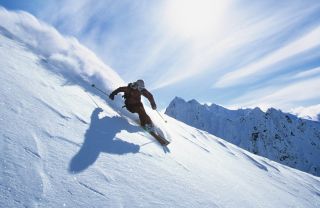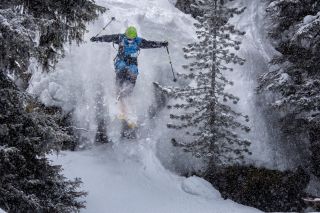Stress
Downhill Skiing Is Dangerous—So Is Life
You don't always have a choice as to which runs you're going to ski in life.
Posted March 17, 2024 Reviewed by Hara Estroff Marano
Key points
- Life is similar to skiing in that regardless of your skill level, you must get down the hill.
- If you are in over your head, you are not enjoying the ski run or your life.
- You have little choice in life regarding the difficulty of runs you will have to navigate.
- Increasing your life skills allows you to enjoy it much more, and it allows healing.
Looking down a hill well beyond your skill level is terrifying. Downhill skis are designed to be fast and hard to turn without knowing what to do. Conversely, understanding how to use the edges, distribute your weight, time weight transfers, and position your shoulders, hips, and knees allows you to ski difficult terrain with ease. It is satisfying and exhilarating. It is a technical sport that requires years of practice to master.

I went skiing for the first time when I was 14. Our family was not a ski family, but my father decided to take us on a ski vacation to Mammoth Mountain. The whole trip was somewhat of a disaster, as we were so unprepared. I got to the mountain too late for ski school, so my brother, who had skied once, said he would teach me. We found ourselves on an intermediate slope. In spite of his best non-efforts, I twisted my knee, tore one of the ligaments, and ended up in a long leg cast for eight weeks.
No choice
For those of you who have never skied, being on a slope that is above your skill level is not merely frightening but terrifying. Most skiers have experienced this scenario at least once. But any life situation in which you are in above your head elicits a similar response. What makes skiing unique is that you have no choice. You must get down the hill by the end of the day.
You must also make it through life. Consider life as a major ski resort with many choices except one. When you check into the ticket window every morning, instead of buying a ticket, you are assigned to ride one chairlift. You must ride it regardless of the difficulty of the run or your expertise. No one is going to help you down.
Ski runs
The difficulty of a skin run is rated by color. In the U.S., the easiest, double green circle, slope is called the “magic carpet,” because you stand with your skis on a moving belt and get off on a hill that is almost flat. Single green circles are usually accessed by chairlifts, and the runs are smooth and gentle for beginners. A blue square indicates a somewhat steeper slope for intermediate skiers. Some runs have bumps called moguls. Black diamond runs are steep, usually ungroomed, and often have many moguls. Double black diamond runs are challenging even for high-level skiers and dangerous for beginners. There are many warning signs saying, “experts only.”
Life
One problem everyone faces is that life is full of double black diamond runs, and they are not usually marked. Anytime you are on a hill that is beyond your skill level, it is problematic. A beginner skier on an intermediate hill is not having a great time. Consider a beginner skier who has to navigate a double black diamond run. It is truly terrifying.
The core cause of all chronic mental and physical illness is sustained levels of stress. Stress shifts body physiology into a state of threat, a state of preparedness for danger, marked by the flight-or-fight response. This state is necessary in order to stay alive. But it is very costly if it is sustained. The reason why chronic stress is so deadly is that it affords you no time to rest and regenerate. For example, the reason your heart can function for many decades is that it gets to rest between beats.
Sustained threat physiology is what creates mental and physical illness. And what determines your body's physiological state is the balance between the circumstances you are in and the coping mechanisms that you have acquired for managing life's runs. Depending on your coping skills, your body can be in a state of threat, which is helpful in the short term but destructive of tissue in the long term, or it can be in a state of safety, which permits repair and regeneration of tissue. The essence of healing is decreasing your exposure to threat physiology and increasing time in a state of safety.
Healing thus depends on acquired skills. They involve processing input (stress) so that it has less negative impact on your nervous system, calming the nervous system so that it is less reactive, and directly countering your threat physiology. All three routes are accessible daily, and the skills require repetition to become automatic. Over time, you will be a “professional at living life.”
On the slopes
Anytime you are in over your head, your body will be in a state of threat physiology. Your goal is to increase your skill level to the point where any hill is not overwhelmingly frightening to you. Before you begin, you must have equipment that is safe and comfortable and be dressed appropriately for the weather conditions (too hot or too cold is a problem). Skiing requires strength, flexibility, and endurance, so conditioning is also important.
Once your skis are on, the next step is that you must learn how to stop, regardless how steep the hill is. Even on a bunny hill, this is critical. On expert terrain, you must be able to set a firm edge. You cannot learn anything until you can stop. My wife endlessly reminds me that the first time I took her skiing, I neglected this detail, and she stopped by running into a building. It was at a slow speed, so she wasn’t injured; but she wasn’t too happy.
Why do you ski? Why do you live?
Your desire is to enjoy your experience as much as possible. For example, if you are an intermediate skier on a blue slope, you can feel relaxed, work on skills, let the skis do the work, and have a great time. Isn’t that the reason you are skiing?
But what if you are a blue skier on a black run or a green skier on a double black diamond run? It really is terrifying, and one such experience can cause people to quit forever. But you have no choice. Life keeps coming at all of us, and there is no end to the challenges. What are you going to do? You cannot stay on top of the hill all night. You don’t want to fall down a double black run at a high speed; it happens and people get hurt.

Then consider the scenario of an expert skier on an intermediate run well below his or skill level. Normally, it is an enjoyable experience. But today is 12 degrees, the wind is blowing about 20 mph, it is foggy, hard to see, and extremely icy. The expert skier must go into a defensive survival mode and might be OK. But it isn’t much fun. What if you are green skier on a double black diamond run in these conditions? Beyond terrifying, it is life-threatening.
Good luck! Or is it luck?
You cannot control most of the circumstances in your life, but you can develop skills to deal with them more effectively. Many more days will be enjoyable, and you also possess the confidence to deal with severe adversity. Your body frequently goes into threat physiology because it is protecting you. But you don’t have to stay there.
Few of us are taught the life skills of regulating our physiology in response to stress, and even fewer are taught to nurture joy. You might say, I don’t want to learn how to ski. I don’t like it. Good luck. You still have to check in at the ticket window and get your assignment for the day.
We spend a lot of time learning many different skills but not much attention is spent on learning how to navigate life.




